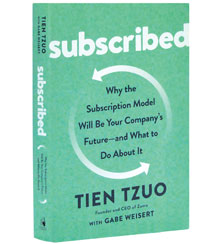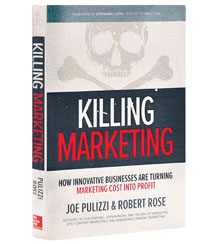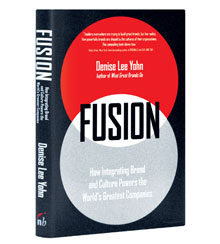Best Business Books 2018: Marketing
Marketing Is Dead! Long Live Marketing! See also Top Shelf Picks: Best Business Books 2018.
Tien Tzuo
Subscribed: Why the Subscription Model Will Be Your Company’s Future — and What to Do About It (Portfolio/Penguin, 2018)
*A TOP SHELF PICK
Joe Pulizzi and Robert Rose
Killing Marketing: How Innovative Businesses Are Turning Marketing Cost into Profit (McGraw-Hill Education, 2018)
Denise Lee Yohn
Fusion: How Integrating Brand and Culture Powers the World’s Greatest Companies (Nicholas Brealey Publishing, 2018)
First, a confession. Having selected the best business books on marketing for s+b for a number of years now, I must say: Nobody writes books about marketing anymore.
Marketing hasn’t disappeared, exactly. However, to assume that some carefully crafted banner ads, 30-second television commercials, eye-catching billboards, and a mobile app are all it takes to move product — well, that idea of marketing is on the way out. Marketers continue to produce ads, but almost as air cover in case their efforts to engage customers through great digital, retail, and customer service experiences don’t pan out. Few are bold enough to completely abandon traditional marketing. And yet those old-school tactics are seldom discussed, unless the topic is how to do away with needing them. You’ll note that only one of this year’s books has the word marketing in the title. In an ominous sign, it appears after the word killing.
Only one of this year’s books has the word marketing in the title. In an ominous sign, it appears after the word killing.
What replaces marketing? Well, how about ongoing customer engagement in which attention and sales are earned? Tien Tzuo, author of this year’s best business book on marketing, Subscribed: Why the Subscription Model Will Be Your Company’s Future — and What to Do About It, explains: “I think everyone would agree that brands are still very important, but today you communicate your brand through experiences, not ads.” In this model, marketing isn’t an appendage to each enterprise’s business model — it’s at the heart of it.
Tzuo is the founder and CEO of Zuora, which creates software that companies use to manage subscriptions. And to a degree, the book is an effective pitch for the company’s services. Yet Subscribed resonates so deeply because if you look closely, you’ll notice the subscription model has been building momentum in surprising places. Until recently, subscriptions were limited to magazines, newspapers, and the book- or wine-of-the-month club. But now, consumers can — and do — subscribe to makeup (Birchbox), razors (Dollar Shave Club), clothes (Stitch Fix), food (HelloFresh), socks (Sock Panda), and flights (Surf Air), along with any number of digital services, such as software (Adobe) and video entertainment (Netflix).
The benefit for the consumer is obvious. The convenience of having razors, or carefully curated recipe items, or Drake’s latest release simply arrive on your doorstep or in your Spotify app is hard for today’s harried masses to resist.
However, it could be argued the benefits that consumers reap from subscriptions pale in comparison with what companies gain: vital data that helps them constantly iterate offerings and deepen relationships with their customers, along with a recurring revenue stream that can be transformative for businesses. Subscriptions also enable companies to evolve from the 20th-century business of selling products to the modern model of providing services.
Take the U.K.-based snack box company Graze, which sends its subscribers boxes of healthy snacks every few weeks and asks them to fill out a simple online form about what they liked and didn’t like. Because of the insights the company has gained through this continual feedback, it saw no reason to immediately switch up its offerings when it launched in the United States. “We just took our existing product line and dumped it on the U.S. market, because the system adjusts itself,” the company’s CEO, Anthony Fletcher, told Tzuo. Graze had no success in turning U.S. customers on to Marmite, a yeast extract spread — they soon made clear their preference for spicy barbecue snacks — but the CEO emphasized that expensive market research efforts made prior to entering a market had very often failed. With the market research “baked into the service,” as Tzuo notes, the feedback is immediate and comparatively cheap.
Of all the marketing-related books I’ve read over the years, Subscribed is the first one to spend considerable time discussing how new business models impact the bottom line. Tzuo devotes an entire chapter to the need to change accounting practices for subscription services around the line item of annual recurring revenue, or the amount of revenue expected from the subscription base for the coming year. This idea has ripple effects throughout the balance sheet; Tzuo advocates for sales and marketing to become matched to future revenue, because the entire model is built on the premise of a business’s future with its subscribers, not the number of units sold — and sales and marketing costs incurred — in the previous quarter or year. If you, um, subscribe to the idea that marketing is now at the heart of business models, then giving it such weight in the back office makes sense.
The Character of Content
Killing Marketing: How Innovative Businesses Are Turning Marketing Cost into Profit provides a different spin on the idea that the path forward for marketers is to build long-lasting relationships with customers rather than bombard them with advertising messaging. Authors Joe Pulizzi and Robert Rose, founder and chief strategy advisor, respectively, of the Content Marketing Institute, contend that the path to success goes through — you guessed it — content marketing. Several marketing books published this year (and in previous years) make this case. But what differentiates Killing Marketing is its contention that content marketing can actually become a profit center, rather than just a more effective marketing method, for virtually any business. “We must rebirth a new marketing that makes its living from building audiences for long periods of time,” say the authors, “so that we might hold their attention through experiences that place us squarely in the initial consideration set when they are looking for a solution.”
Doing so requires owning your media. That’s a fundamentally different approach from that of traditional advertising, in which audiences are essentially rented from the media properties in which marketers’ ads appear. An entirely new idea? Maybe not. But it is one made more resonant at a time when customer data is the coin of the realm. Those deeply immersed in the marketing business know that one of the biggest frustrations is the predominance of Facebook and Google in the digital advertising ecosystem; together these platforms account for about 90 percent of the industry’s growth, per Digital Content Next. In exchange for hoovering up all those dollars, they provide marketers only aggregated data on their customers that can’t be exported into their own databases. A sense of being held hostage by the duopoly provides reason enough for marketers to try their hand at the content business.
Killing Marketing points out that content creation — similar to the subscriber bases championed in Subscribed — solves the data problem, and then some. Kraft, which publishes Food & Family Magazine, not only makes money from the publication but also uses the data it gathers to inform its digital media buying and make it more effective.
Pulizzi and Rose believe content marketing can go one step further and become a profit center because “the new media business model and the new marketing business model are exactly the same.” Essentially, they believe that if you are in the business of building an audience for your products, you should be able to build a business for your content.
The Walt Disney Company, the book notes, was one of the first to do this. Its movies and other content, such as comic books, built a fan base that was then leveraged to build an entire Disney experience, from merchandise to theme parks. In the consumer packaged goods industry, there’s energy drink maker Red Bull, whose Red Bull Media House includes print, Red Bull TV, documentaries, a content pool of premium imagery in sports, a record label, and Speedweek, a motor sports brand.
Arrow Electronics, the largest distributor in the world of items such as circuit boards and semiconductors, is frequently cited as an example of a B2B company pursuing this strategy. The company supplemented some of its owned content by buying 16 engineering content properties from Hearst in 2015 and another portfolio of specialist publications from UBM in 2016. Must-reads for the electrical engineering audience, properties such as Robotics China and EE Times were nonetheless languishing at large media companies with limited funds and low interest in keeping them going. They are now housed in AspenCore, an entirely separate division of Arrow, creating a firewall between product and content.
Content as a profit center is a strong idea. But I didn’t find Killing Marketing as compelling as Subscribed because its authors are asking companies to make a shift in their mind-set that is even more profound. After all, Subscribed pushes businesses to move to a new sales model for goods and services they already sell. The Arrows and Red Bulls of the world are to be commended, but they may also be unicorns in their ability to separate church and state and maintain the editorial credibility of their content. As any business reporter will tell you, corporations don’t always understand how true, objective editorial content works. They often have extreme difficulty moving from messaging they control (advertising) to messaging they don’t (editorial content). Still, Killing Marketing is a worthwhile read because it’s brave enough to realize that marketing as we’ve known it is no longer enough — and to provide companies with an alternative.
Culture Clubs
Starbucks, Southwest, Patagonia. They are different brands, but those who closely study successful companies today might point to one similarity: These companies’ brands are the embodiment of their culture, and vice versa. Few brands actually achieve this state, but it’s a major quest these days. That’s why Denise Lee Yohn’s Fusion: How Integrating Brand and Culture Powers the World’s Greatest Companies is a welcome arrival.
Unlike the other two books reviewed here, Fusion is not a manifesto — it doesn’t have to be, because its premise is accepted wisdom. Yohn writes, “When your culture and brand are interdependent and mutually reinforcing, there is a strong connection between how employees experience every aspect of their work life during their tenure in your organization…and how customers experience your brand.”
This means Fusion can progress swiftly to the business of how companies can better merge their brand and corporate culture. And Yohn does so with great specificity, partially by offering a number of online assessment tools to move readers forward. Fusion is a highly detailed how-to.
It is also loaded with examples of all types that can serve as inspirational touchpoints for the reader. In the chapter “Sweat the Small Stuff,” Yohn recounts what she experienced at a conference for a US$8.5 billion company. At the conference opening, “a man decked out in traditional Hawaiian garb appeared in the far corner and started blowing a conch shell.” Where was this? Salesforce’s annual Dreamforce conference, where Yohn witnessed a powerful example of how the software giant has built its culture around the Hawaiian concept of family.
The conference wasn’t a one-off in which CEO Marc Benioff thought it might be fun to play around with Hawaiian symbolism for a few days. In fact, Hawaii is central to the company’s culture, expressing itself in ways big and small, from the routines at massive conferences to some employees’ tradition of donning Hawaiian shirts on Fridays.
Yohn’s analysis of brand–culture fusion even works its way down to the employee manual. The staff guide for the iconic Ann Arbor, Mich.–based deli Zingerman’s instructs employees on how to properly clean a knife and lays out the company’s harassment policies. That’s not surprising. But, in keeping with its playful brand, “even those are written in such plain and clear language and presented in such a visually attractive manner that any employee who takes the time to read them might actually understand and value these policies,” Yohn writes.
Rewriting your employee manual may not be the first thing you do after reading Fusion. But the book’s straightforward, detailed approach shows just how far a company can go to build a strong connection between brand and culture. In so doing, the book should give readers the level of confidence they need to take on a Herculean task that is becoming more essential to truly differentiating businesses.
The most compelling thing about these three books is that although chief marketing officers and their teams should certainly read them and take their lessons to heart, so should many other executives. If you accept that marketing is no longer just about ads, it follows that as older forms of marketing are lessening in value, new forms are taking hold — and in every case, having new and profound effects across the enterprise.
Author profile:
- Catharine P. Taylor has covered digital media since 1994, writing for publications including Adweek and Advertising Age. She also wrote the weekly Social Media Insider column for MediaPost for seven years, and is a program director for the Conference Board, managing some of its marketing-focused events.







